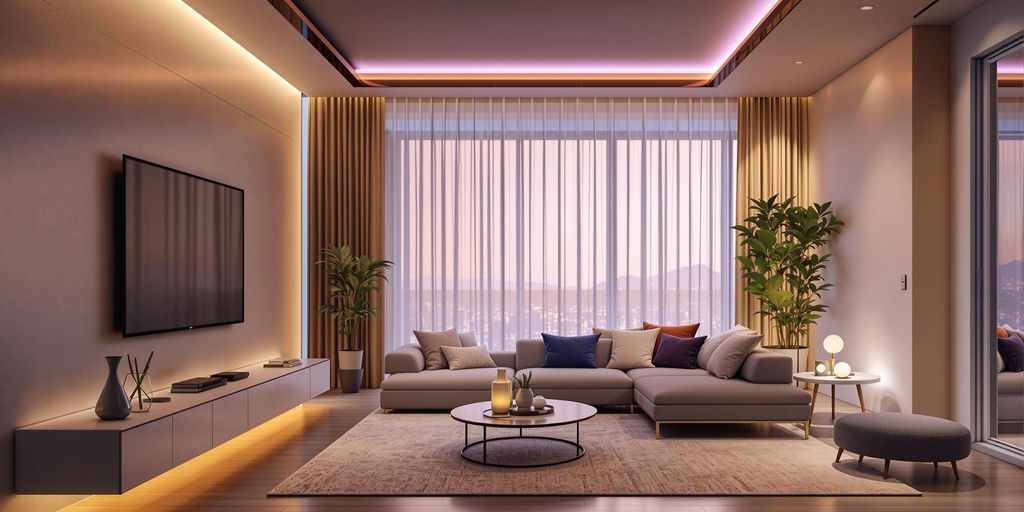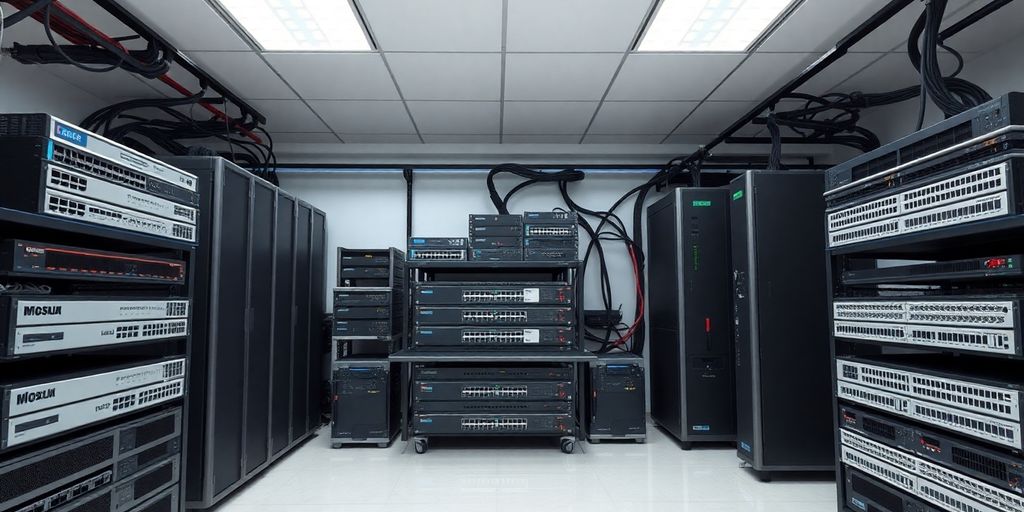Lighting control systems are shaking up the way we think about home lighting. Gone are the days of just flipping a switch. Now, with the rise of smart technology, you can control your lights with your phone or even your voice. This isn’t just about convenience; it’s about creating the perfect mood, saving energy, and even boosting your home’s security. Whether you’re setting the scene for a movie night or making sure your house looks occupied while you’re on vacation, smart lighting has got you covered. Let’s dive into what makes these systems so game-changing and what the future holds.
Key Takeaways
- Smart lighting systems are transforming home lighting with features like remote control and voice activation.
- These systems not only add convenience but also enhance security by allowing remote monitoring and control.
- Energy efficiency is a significant benefit, helping reduce electricity bills and environmental impact.
- Integration with other smart devices creates a seamless smart home experience.
- Future trends include more intuitive controls and sustainable solutions for eco-friendly living.
Innovative Features of Modern Lighting Control Systems
Wireless Control and Automation
Smart lighting systems have come a long way, and one of their standout features is wireless control. Picture this: you’re relaxing on your couch, and with just a few taps on your phone or a voice command, you can adjust the lights. Whether you’re home or not, controlling your lighting setup has never been easier. This level of convenience is now a standard expectation in smart homes. Plus, setting schedules or automating your lights to turn on and off at certain times adds an extra layer of security and energy efficiency.
Energy Efficiency and Sustainability
Energy efficiency is not just a buzzword; it’s a necessity. Smart lighting systems are designed to use less power, thanks to LED technology. These lights provide the same brightness as traditional bulbs but consume way less energy. Here’s a quick list of what makes them energy-efficient:
- LED bulbs consume significantly less energy than incandescent bulbs.
- Automated schedules ensure lights are only on when needed.
- Dimming capabilities reduce power consumption when full brightness isn’t necessary.
By cutting down on energy use, these systems help reduce your carbon footprint and save on electricity bills.
Integration with Smart Home Devices
In today’s interconnected world, smart lighting systems don’t just stand alone. They integrate seamlessly with other smart home devices. From thermostats to security systems, your lighting can be part of a broader interoperable network that enhances your living experience. Imagine the lights dimming automatically when you start a movie or turning on when your security system detects movement. It’s all about creating a cohesive and responsive environment that adapts to your lifestyle.
Enhancing Home Ambiance with Smart Lighting
Customization and Scene Setting
Imagine being able to change the vibe of your room with just a few taps on your phone. Smart lighting lets you do exactly that. You can adjust the color, brightness, and even the direction of the light to fit your mood or activity. Whether you’re hosting a party or having a quiet night in, smart lighting can help set the perfect scene. It’s like having a personal lighting designer at your fingertips.
Smart Lighting for Health and Well-being
Lighting isn’t just about visibility; it can impact your health too. Smart lighting systems can mimic natural daylight, which helps regulate your sleep patterns and boosts your mood. In the morning, you can wake up to a gentle sunrise simulation, making the transition from sleep to wakefulness more pleasant. At night, a warm, soothing light can help you wind down and prepare for a good night’s sleep.
Smart Lighting for Entertainment
When it comes to entertainment, smart lighting can take things up a notch. Sync your lights with your TV or music for a fully immersive experience. Imagine your living room turning into a mini-theater with lights dimming automatically as the movie starts. Or, picture your lights pulsing in time with your favorite tunes, turning your space into a lively dance floor. With smart lighting, your home becomes a more dynamic and engaging place for entertainment.
"With smart lighting, you have the power to transform your living space with just a few taps on your smartphone or a simple voice command."
As days shorten, utilizing smart home scenes and plugs can enhance ambiance by effortlessly transitioning spaces from day to night.
Future Trends in Lighting Control Systems

Interconnectivity with IoT Devices
Imagine walking into your living room, and your lights automatically adjust to your favorite setting, the thermostat tweaks itself to the perfect temperature, and your preferred playlist starts playing—all without lifting a finger. This is the future of smart lighting, where interconnectivity with IoT devices transforms your home into a seamless, automated environment. As smart lighting systems integrate more deeply with other smart home devices, they not only offer convenience but also enhance the overall living experience. This interconnectedness will soon be a standard feature, making homes smarter and more intuitive than ever before.
Gesture and Motion Control
Have you ever wished you could just wave your hand to turn off the lights? Well, gesture and motion control in lighting systems are making this a reality. These systems are being developed to respond to simple gestures, providing a hands-free way to control lighting. Whether it’s dimming the lights for a movie night or switching them off as you leave a room, this innovation offers a new level of interaction and ease. With ongoing advancements, gesture control is set to become more precise and widely available, changing how we interact with our home environments.
Sustainable Lighting Solutions
As we become more conscious of our environmental impact, sustainable lighting solutions are gaining traction. The future of lighting control systems includes more energy-efficient options, such as advanced LED lights that consume less power. Additionally, the integration of renewable energy sources to power these systems is on the rise, aligning with global sustainability goals. These eco-friendly solutions not only help reduce carbon footprints but also lead to cost savings in the long run. Embracing sustainable lighting is not just a trend—it’s a step towards a greener future.
"The future of smart lighting is bright and filled with possibilities. From seamless integration with other smart devices to intuitive gesture and motion control, these advancements will enhance convenience and elevate the overall smart home experience. Moreover, the focus on sustainability will drive the development of more energy-efficient and environmentally friendly lighting solutions."
For more insights into how smart LED lighting can enhance convenience and promote well-being, explore our detailed guide.
Integration of Lighting Control Systems in Smart Homes

Voice Control and Virtual Assistants
In today’s tech-savvy world, voice control is not just a novelty—it’s a game-changer. Imagine walking into your home and simply saying, "Turn on the lights," and voila, your living room is bathed in light. By integrating smart lighting with virtual assistants like Alexa or Google Assistant, you can easily control your lighting with just your voice. This feature is especially handy when your hands are full, or you’re just too comfy on the couch to get up. Smart lighting systems that work seamlessly with voice assistants can turn your home into a futuristic space where convenience rules.
Integration with Home Automation Systems
Smart lighting isn’t just about turning lights on and off. It’s about creating an environment that suits your lifestyle. When integrated with home automation systems, smart lighting can be programmed to adjust based on time of day, activity, or even mood. For instance, you can set your lights to dim when you start a movie or brighten when you’re cooking dinner. Using systems like Control4, you can enhance your home automation by not only controlling lights but also managing energy efficiency and personalizing your settings.
Smart Lighting and Security
Security is a top priority for any homeowner, and smart lighting can play a crucial role. By syncing your lighting with security systems, you can simulate occupancy even when you’re miles away. This could mean having your lights turn on and off at random times to mimic someone being home, deterring potential intruders. Additionally, smart lighting can be connected to motion sensors, illuminating dark corners of your property when movement is detected. This integration not only enhances security but also provides peace of mind, knowing your home is well-protected.
Choosing the Right Lighting Control System for Your Home
Compatibility with Existing Setups
When picking out a lighting control system, it’s important to think about how it fits with what you already have. Most of these systems are made to work with your current wiring and fixtures, so you don’t need to tear up your house to install them. But, always double-check that the system you choose can talk to your other smart devices, like speakers or home automation gadgets. This makes everything work together smoothly, giving you a better smart home experience.
Hub vs. Hubless Systems
Some smart lighting setups need a hub or a central device to function, while others can connect directly through Wi-Fi or Bluetooth. If you’re going for a hub-based system, make sure it’s easy to set up and manage. Hubless systems might be more straightforward, but they can have limitations in terms of connectivity and control. Think about what fits best with your lifestyle and tech comfort level.
Remote Control Capabilities
One of the coolest things about smart lighting is controlling it from anywhere. As long as your system is hooked up to the internet, you can tweak the lights using an app on your phone or a voice assistant. This means you can adjust your lights even when you’re not home, which is super handy for security or just setting the right vibe before you walk in the door.
Tip: When selecting a lighting control system, consider what you want to achieve. Setting clear goals with your setup helps ensure it meets your specific needs and expectations. This step is key to making sure your new system fits seamlessly into your lifestyle.
The Role of Lighting Control Systems in Energy Management
Smart lighting systems are more than just fancy gadgets; they’re a practical way to manage energy use in homes. By tracking how much power your lights consume, these systems help you understand and adjust your usage. This means you can save on your electric bill without sacrificing comfort. Many systems offer real-time data, letting you see exactly where your energy goes and adjust accordingly.
Smart Scheduling and Automation
Imagine your lights turning on just before you get home or dimming automatically at bedtime. With smart scheduling, you can set your lights to follow a routine that suits your lifestyle, reducing unnecessary usage. Automated systems can also sync with daylight, adjusting brightness based on natural light levels, which not only saves energy but also creates a pleasant living environment.
Reducing Carbon Footprint
By cutting down on energy waste, smart lighting systems contribute to a smaller carbon footprint. They use energy-efficient LED bulbs and allow for precise control over light usage, ensuring that lights are only on when needed. This not only helps the planet but also promotes a more sustainable lifestyle for homeowners.
Smart lighting isn’t just about convenience; it’s about making a real impact on energy consumption and environmental health. As more people adopt these systems, the collective reduction in energy use can make a significant difference.
The Impact of Lighting Control Systems on Home Security
Automated Lighting for Security
Smart lighting systems have completely changed how we think about home security. By automating your lights, you can make it look like someone is always home, even when you’re miles away. This is done by programming your lights to turn on and off at random times, simulating a typical occupancy pattern. Such a setup can deter potential intruders who might be watching your home. Imagine you’re on vacation, but your house still looks lively with lights coming on in the evening and going off at bedtime. It’s like having a security guard at your house, but way cheaper.
Integration with Security Systems
These lighting systems don’t just work alone; they can team up with other security gadgets. For example, you can connect your lights with security cameras or motion sensors. If the sensors detect movement, the lights can flash on, catching any intruder off guard and possibly scaring them off. This integration means your home security isn’t just about locks and alarms anymore; it’s about creating a smart, responsive environment that reacts to potential threats.
Remote Monitoring and Alerts
With smart lighting, you’re not limited to just automation. You can also keep an eye on things remotely. If something unusual happens, like a light turning on when it shouldn’t, you’ll get an alert on your phone. This way, you can check in and make sure everything’s okay. Plus, you can control your lights from anywhere, so if you forgot to turn them off before leaving, it’s no big deal. This kind of remote access and control adds an extra layer of security and peace of mind, knowing you can manage your home’s lighting and security from anywhere.
Conclusion
So, there you have it. Smart lighting is changing the game in how we light up our homes. It’s not just about flipping a switch anymore. With all these new features, like controlling lights from your phone or having them sync with your music, it’s like living in the future. Plus, it’s not just cool; it’s practical. You can save energy, make your home more secure, and even set the perfect mood for any occasion. As tech keeps getting better, who knows what else we’ll be able to do with our lights? It’s an exciting time for sure. So, if you haven’t already, maybe it’s time to think about making your home a little smarter with some new lighting.
Frequently Asked Questions
What is smart lighting technology?
Smart lighting technology lets you control your lights using a smartphone, tablet, or voice commands. You can change brightness, colors, and even set schedules.
How does smart lighting help save energy?
Smart lighting helps save energy by letting you schedule when lights turn on or off and adjust brightness. Some systems even learn your habits to save more energy.
Can I use smart lighting with my current home setup?
Yes, most smart lighting systems work with what you already have at home. You don’t need to do major changes or renovations.
Do I need a special device to control smart lights?
Some smart lights need a hub to connect, but others can work with just Wi-Fi or Bluetooth. Check your system’s needs before buying.
Can I control smart lights when I’m not home?
Yes, you can control smart lights remotely if they are connected to the internet. Use a smartphone app or virtual assistant to manage them from anywhere.
How do smart lights improve home security?
Smart lights can make your home safer by turning on automatically when someone approaches or setting schedules to make it look like someone is home.



